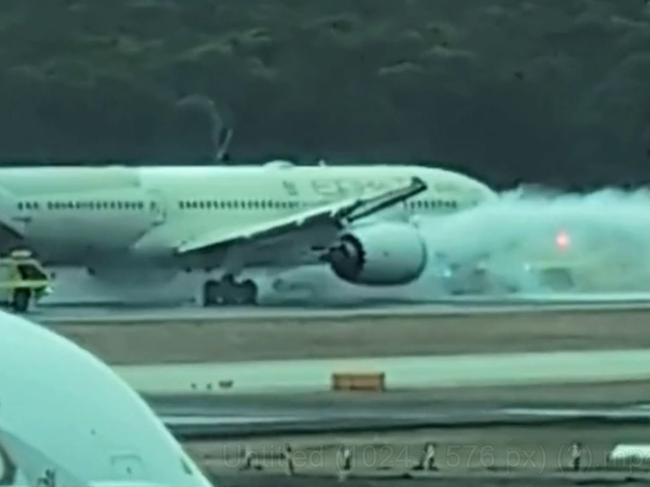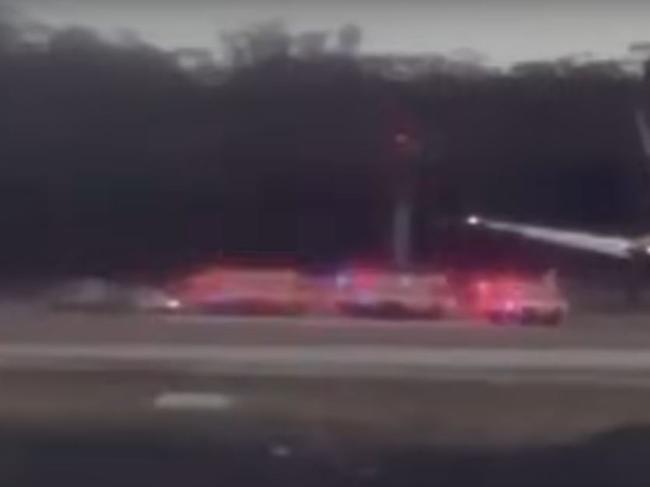Boeing 787 Dreamliner was travelling at just over 300km/h when takeoff was aborted due to a ‘technical fault’
Aviation specialists have revealed how the frightening situation unfolded on an Etihad Airways plane travelling from Melbourne to Abu Dhabi.
Victoria
Don't miss out on the headlines from Victoria. Followed categories will be added to My News.
A potential engine malfunction is believed to be behind the aborted take-off of an international flight out of Melbourne carrying hundreds of passengers.
The wheels of an Etihad Airways flight melted in an inferno after a technical fault forced the pilot to slam on the brakes while speeding down the runway at more than 300km/h.
Takeoff for almost 300 passengers on flight EY461 from Melbourne to Abu Dhabi on Sunday night was aborted in a rare “split second” move as the plane was set to lift off at Tullamarine.
Flight data provided to the Herald Sun indicated the Boeing 787 Dreamliner was travelling at just over 300km/h when takeoff was aborted about 6.15pm due to an unspecified “technical fault” that has been identified as a high gas temperature in the plane’s right engine.
Planes can fly with one working engine, but it is believed a problem with the right hand engine was significant enough for the pilots to abandon take-off.
The sudden braking caused fearful passengers to lurch forward in their seats.
Aviation specialists say the high volume of heat generated by slamming on the brakes at that speed spread to the plane’s nose wheels, causing them to melt.

But they say passengers, who branded the ordeal a “shambles”, should rest assured that is what should have happened during the “rare” emergency, and was not the error believed to have caused the takeoff to abort.
“Just like if you stop a car really hard, the brakes get hot, and that heat from the brakes transfers into the wheels,” Aviation Projects managing director Keith Tonkin said.
“That heat can make the gas (nitrogen) inside the tyre expand, and rather than allow that expansion to happen to the point where the tyre explodes, aircraft wheels are fitted with a metal that melts at a certain temperature to allow the air inside the tyre to escape under control, and that avoids explosion.

“The fusible plug has melted and the air has gone out of the tyres. That’s exactly how they’re designed to work.”
The exact fault that caused the aborted takeoff remains unclear, but Flight Safety Group chief executive Colin Weir said such drastic action was usually only taken if a pilot believed the plane would not successfully fly or complete its landing.
“It happened on the critical phase of the takeoff run,” Mr Weir said.
“The crew must have been under extreme pressure because you have to be very, very quick to decide and weigh up the possibility of an accident if you take off anyway or whether you’re going to reject the takeoff at that point and risk braking issues and possibly coming off the runway or the end of the runway,”
Neil Hansford of Strategic Airline Solutions said the pilots acted swiftly and protected hundreds of passengers from potential disaster.
“You see how busy Melbourne and Sydney are and I can’t remember the last rejected takeoff,” Mr Hansford said.
“They’ve followed the procedure while he’s still on the ground, to keep it on the ground.
“If you keep it on the ground, everybody will walk off it (the plane). If you take off and something goes wrong, that’s not normally the same.”
Melburnian Josh Bennett, who is currently living in London but returned home for Christmas and was on board the abandoned flight, told the Herald Sun the ordeal was a “complete shambles”.
“It started to take off at full speed and then the brakes slammed on and we all came lunging forward in our seats,” he said.
“The woman next to me was in the brace position and we were like, oh my god, what is going on?
“We were right up the runway, just about to go up into the sky, that’s the scary thing.”
Mr Bennett said there were barely any Etihad staff at Melbourne Airport to help the passengers.
“When we finally disembarked and got back into the airport hours later … there were no Etihad staff there, no one knew what to do,” he said.
“Staff said: ‘If you can leave the airport, we’ll give you an Uber voucher. If not, we’ll get you an airport hotel.’ But we were like what about our bags? And they said well they’re on the runway so we can’t touch them.
“I was helping this old lady because she was deaf and couldn’t hear what they were saying. She was really traumatised. I got to the counter with her and she started to cry because all of her belongings were on the plane.”
He said he finally got an email from Etihad on Monday morning, informing him that he had been transferred to a different flight with Singapore Airlines.
“I came to the airport (on Monday morning) and there were no Etihad staff to talk to. And when I called them no one seemed to know anything,” he said. “I finally got my bags back at midday (on Monday).”
Another passenger on the flight, Vince, said the plane brakes went on “quickly” and “hard”.
“We just basically did the normal check-in, got onto the plane, nothing untoward. And just as we were about to take off full speed ahead … the brakes went on quite quickly, quite hard,” he told 3AW.
“Obviously some of the passengers surrounding were a bit scared and grabbing onto things, trying to make sure everyone was OK.
“The brakes went on a couple of times quite hard, and then (there was) some smoke from the right side of the plane.
“Obviously we didn’t know what was happening but a very good decision by the pilot it looks like.”
There are three speed stages an aircraft reaches during take-off and they vary for each aircraft depending on their size, number of passengers and weather conditions.
The Etihad flight had just exceeded the speed when take-off should no longer be aborted.
Pilots run the risk of moving off the runway or past the end of the runway by abandoning take-off after that point.
A plane’s wing flaps cannot be used to slow the aircraft down when abandoning take-off at the last moment because their functions are only programmed for landing at that point in a flight, placing more pressure and heat on the brakes.
A plane’s nose wheels also can also carry heat from its previous flight depending on when it landed at an airport before its next scheduled trip, and from taxiing on the runway before takeoff.
The Australian Transport Safety Bureau said on Tuesday that the flight crew received an alert to the engine problem before aborting take-off.
An ATSB spokesman said the body would not be investigating the incident and that the pilots followed standard procedures by choosing not to take off.
Pilots undergo training for Sunday’s scenario multiple times a year.


